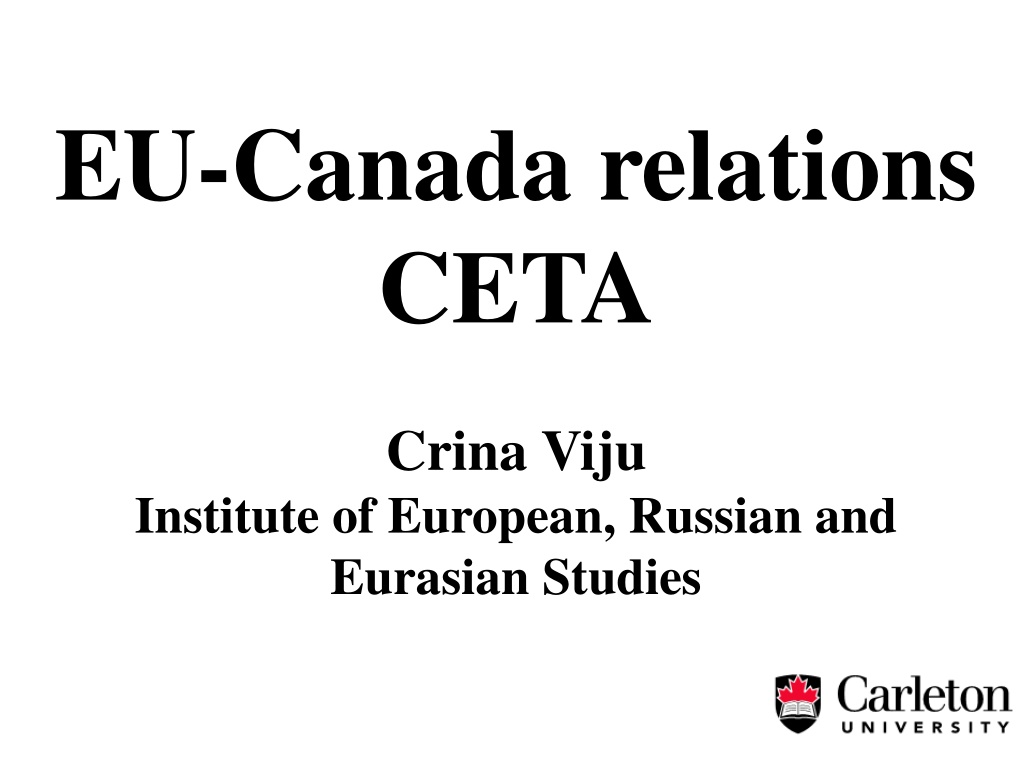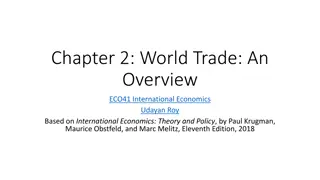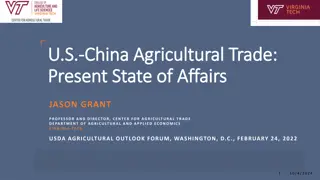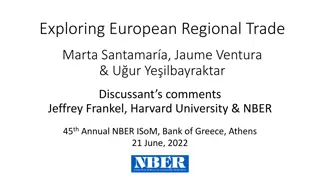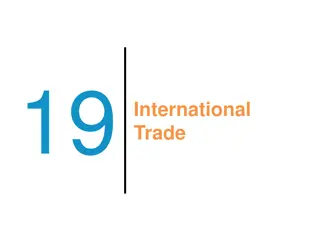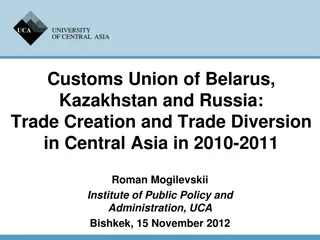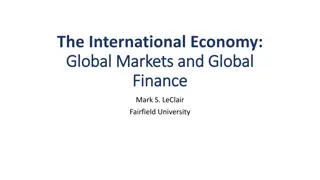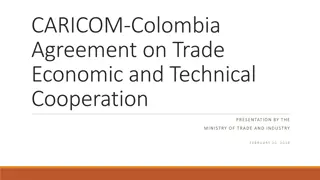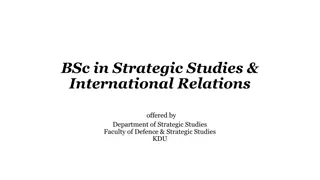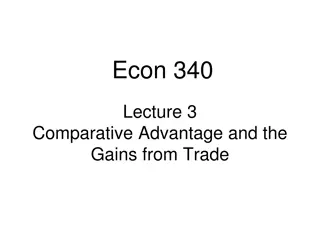EU-Canada Relations: CETA and Trade Dynamics
In-depth analysis of the trade relationship between the EU and Canada, focusing on the Comprehensive Economic and Trade Agreement (CETA). Covers key achievements, potential issues, trade policies, major players, and investment trends between the two entities.
Download Presentation

Please find below an Image/Link to download the presentation.
The content on the website is provided AS IS for your information and personal use only. It may not be sold, licensed, or shared on other websites without obtaining consent from the author. Download presentation by click this link. If you encounter any issues during the download, it is possible that the publisher has removed the file from their server.
E N D
Presentation Transcript
EU-Canada relations CETA Crina Viju Institute of European, Russian and Eurasian Studies
Outline Brief introduction: EU and Canada as trade players; EU and Canada trade policy processes; EU - Canada relations CETA: Main achievements; Possible issues.
The EU a major trading power European Commission, 2013
The EU a major trading power % of global exports, goods, 2012 % of global exports, services, 2012 EU 15% EU 25% United States 11% Others 42% Others 55% Japan 5% United States 18% China 14% India 5% Japan 4% China 6% Europa, 2013
Ten major EU export partners (2012) European Commission, 2013
Ten major import partners (2012) European Commission, 2013
Major investment partners (2011) European Commission, 2013
Canadas top export destinations (goods) 2012 EU, DG Trade 2013
Canadas top import sources (goods) 2012 EU, DG Trade, 2013
EU Canada relations 2013: Canada the 12th most important trading partner for the EU (1.7% of EU external trade in goods) EU the 2nd most important trading partner for Canada (9.8% of Canada external trade in goods) Important trading partners in services EU is Canada s fourth largest source and destination of investment (2011)
New EU trade policy Global Europe Strategy, 2006: an integrated approach to trade policy, linking the internal and external aspects of the EU s competitiveness (EC); Increased market access (tariffs, NTBs); New generation of trade agreements. Europe 2020, 2010: Completion of current negotiating agenda; Deepen trade relations with other strategic partners; Help European businesses access global markets; Create opportunities for investors; More assertive approach to enforcement; Share the benefits of the global economy.
Bilateral agreements European Commission, 2013
Bilateral agreements European Commission, 2013
EU trade policy: Institutional framework European Commission, 2013
Canadas trade policy Run by the Federal Government Canada s Global Commerce Strategy (2007); Action Plan (2012): Pro-trade (since 2006): 9 free trade agreements in force: Panama, Jordan, Colombia, Peru, Honduras, European Free Trade Association (Norway, Switzerland, Iceland, Lichtenstein). 1 free trade agreement signed: South Korea (2014) 1 deep economic and trade agreement concluded: EU; 11 free trade agreements under negotiations: including Japan and India; Trans-Pacific Partnership (TPP): Australia, Brunei, Chile, Canada, Japan, Malaysia, Mexico, New Zealand, Peru, Singapore, the United States, and Vietnam.
EU - Canada Relations 1976: Bilateral Framework Agreement for Commercial and Economic Cooperation: Joint Cooperation Committee Bilateral agreements for various trade issues, sectoral agreements and bilateral consultations or dialogues for various sectors: 1997: cooperation between customs administrators; 1998: Mutual Recognition Agreement (MRA): good manufacturing practices for pharmaceuticals and mandatory conformity procedures in the following sectors: medical devices, tele-communications, terminal equipment, information technology equipment and radio transmitters, electrical safety, electromagnetic compatibility and recreational craft. 1999: competition agreement (cooperation between Competition Bureau Canada and the European Commission); 1999: Veterinary Agreement; 2003: Wine and Spirits Agreement; 2009: Civil Aviation Safety Agreement; 2009: Comprehensive Air Services Agreement; 2005: negotiations on a Trade and Investment Enhancement Agreement (TIEA): Regulatory cooperation, gov. procurement, financial services, IPR
EU Canada relations September 26, 2014 Canada-EU Summit in Ottawa: Conclusion of negotiations for Canada-EU Comprehensive Economic and Trade Agreement (CETA) Conclusion of negotiations for Canada-EU Strategic Partnership Agreement
Comprehensive Economic and Trade Agreement (CETA) October 2008: Joint Study, Assessing the Costs and Benefits of a Closer EU-Canada Economic Partnership: EU GDP increase by 0.08%; Canada GDP increase by 0.77% ($12 billion benefit); May 2009: Launch of CETA negotiations; September 2014: end of CETA negotiations.
Comprehensive Economic and Trade Agreement (CETA): Scope Trade in goods: non-agricultural and agricultural Regulatory measures: sanitary and phytosanitary issues; technical barriers to trade Customs procedures and rules of origin Cross-border trade in services, including mutual recognition of professional qualifications Investment
Comprehensive Economic and Trade Agreement (CETA): Scope Central and sub-central government procurement Regulatory cooperation (laws and procedures) Intellectual property Temporary movement of business persons Competition policy and related matters (monopolies and state enterprises) Institutional arrangements and dispute settlement Sustainable development
Comprehensive Economic and Trade Agreement (CETA): Achievements Tariffs: (surprising outcomes especially for agric. goods) Industrial goods: 99.3% (EU); 99.6% (Canada) at 0% at entry into force; Autos: rule of origin: 50% limit on non-originating materials for 7 years 100,000 vehicles: 70% transaction value or 80% net cost for non-originating materials; Cumulation provision in case of EU-US FTA. Agricultural goods: 93.6% (EU); 92% (Canada) at 0% at entry into force; EU meat markets: Beef and veal market: 50,000 tonnes duty-free in-quota hormone-free; 11,500 tonnes duty-free in-quota of high-quality beef; Bison: 3,000 tonnes duty-free in-quota; Pork: 81,011 tonnes duty-free in-quota; Canada supply-managed products: Poultry and eggs excluded; Cheese: 16,800 tonnes (16,000 tonnes new market access plus 800 tonnes from current WTO quota for new member states); 1,700 tonnes for industrial-use cheese.
Comprehensive Economic and Trade Agreement (CETA): Achievements Services and investment: Negative list: Health care, public education, cultural and other social services excluded; Labour mobility: Process of recognizing professional qualifications streamlined; What about inter-provincial and intra-EU recognition of professional qualifications? Minimize barriers to temporary entry; Quite ambitions. Investment: Investor-state dispute settlement: Clear investor protection standards such as rules followed by arbitration tribunals; Clear rules on the conduct of procedures in arbitration tribunals; Transparent process. A breach of the fair and equitable treatment obligation can only arise when there is: Denial of justice in criminal, civil or administrative proceedings; A fundamental breach of due process, including a fundamental breach of transparency, in judicial and administrative proceedings. Manifest arbitrariness; Targeted discrimination on manifestly wrongful grounds, such as gender, race or religious belief; Abusive treatment of investors, such as coercion, duress and harassment.
Comprehensive Economic and Trade Agreement (CETA): Achievements Government procurement: Established thresholds; Negative list. Comprehensive. Intellectual property: Pharmaceutical: Additional protection for pharmaceutical products never more than 2 years; Canadian-made generics able to be exported during the additional protection period. Federal government cover incremental costs impacts. Geographical Indicators (GIs): Various ways of addressing 179 terms covering foods and beer: Keep the validity of existing Canadian trademarks; Ability to use specified English and French language terms commonly employed in Canada; Limited GI rights on: Asiago, Feta, Fontina, Gorgonzola and Munster (future users accompany them by expressions such as kind , type , style , imitation ); Ability to use components of multi-terms. State-to-state dispute settlement.
Comprehensive Economic and Trade Agreement (CETA): Achievements Regulatory cooperation activities on a voluntary basis; recognizing the right of each Party to determine their desired level of health, safety, environment, and consumer ; Explain why no initiation or withdrawal from cooperation; Ongoing bilateral discussions on regulatory governance; Sharing information, consult, sharing proposed regulations that might have an impact on the other party at an early stage; Regulatory Cooperation Forum: Setting for discussion, assist individual regulators, review initiatives, encourage bilateral cooperation; Outside bodies to conduct assessments on product standards: Parties have to accept decisions.
Comprehensive Economic and Trade Agreement (CETA): Achievements Cooperation in motor vehicles regulations: International standards: on a voluntary basis; Cooperation in biotechnology: Shared objectives: Exchanging information on policies, regulations and risk assessment processes; promoting science-based approval process; low level presence of GMOs; minimize adverse trade impacts of regulatory practices. Substantial progress by establishing various institutional channels through which sector-specific NTBs can be addressed over time; Elimination of small regulatory differences, double testing, inspection procedures (conformity assessment).
Possible issues Let s not forget: Canada between the US and the EU (NAFTA versus CETA) plus TTIP negotiations. Canada described as the major winner of this trade deal: Can the benefits be taken for granted? EU ratification process: Approval only by EU institutions or also EU member states ratification (investment provisions).
Thank you! Questions? Crina Viju: crina.viju@carleton.ca
